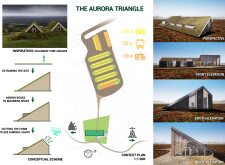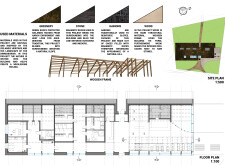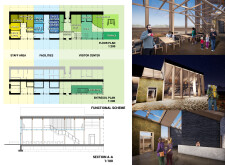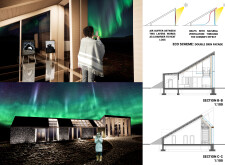5 key facts about this project
At the heart of the Aurora Triangle project is the idea of integrating the building into the landscape. The design takes cues from the existing topography, utilizing it to inform the building's form and spatial organization. This approach not only ensures minimal disruption to the natural environment but also allows the architecture to emerge organically from the site. The structure features a series of modular components that extend usable spaces while maintaining a cohesive overall aesthetic. These modular boxes provide flexibility in the layout, accommodating various functions such as exhibition areas, cafes, and retail spaces.
Materiality plays a crucial role in anchoring the Aurora Triangle project within its context. The choice of materials reflects both sustainability principles and local traditions. Green roofs, for example, are employed to provide insulation and blend the building into the surrounding greenery. Additionally, the use of locally sourced stone enhances the connection to the geological context of the site. The incorporation of gabions—wire mesh structures filled with stones—further reinforces the interplay of architecture and landscape, integrating the building into the terrain while offering practical benefits in terms of erosion control.
The architectural plans reveal a planned spatial arrangement that prioritizes user experience and engagement with nature. Large expanses of glazing are strategically placed to maximize natural light and offer expansive views of the majestic surroundings, allowing visitors to appreciate the auroras during their visit. The floor plan thoughtfully allocates space for essential functions, including areas for dining, exhibitions, and visitor services, ensuring a seamless flow throughout the building. The thoughtful organization of these spaces not only enhances functionality but also promotes a sense of community among visitors.
Unique design approaches further define the character of the project. For instance, the building’s double-skin facade serves a dual purpose: it creates a thermal buffer that enhances energy efficiency while promoting natural ventilation. This innovative technique exemplifies a commitment to environmental sustainability, aligning with Iceland's climatic challenges. Additionally, the architectural sections display a careful consideration of human scale and interaction, promoting a sense of connection between the indoors and outdoors.
The site plan establishes a cohesive relationship between the project and its surroundings, with pathways designed to encourage visitors to explore the natural landscape. This thoughtful planning ensures easy accessibility for a variety of user groups, establishing the building as a welcoming destination for locals and tourists alike. Furthermore, the integration of outdoor spaces highlights the importance of the environmental context, allowing visitors to immerse themselves in the unique flora and fauna of the area.
In summary, the Aurora Triangle project represents a harmonious blend of architecture and landscape, emphasizing sustainable practices and cultural relevance. The careful consideration of materiality, spatial organization, and environmental interaction underscores the project's thoughtful design approach. The nuanced architectural ideas presented through this project invite further exploration, encouraging interested individuals to delve deeper into the architectural plans, sections, and designs that inform its conception. For those looking to gain a richer understanding of this unique architectural venture, a closer examination of its presentation will reveal the detailed thought processes behind each element of this compelling project.


























